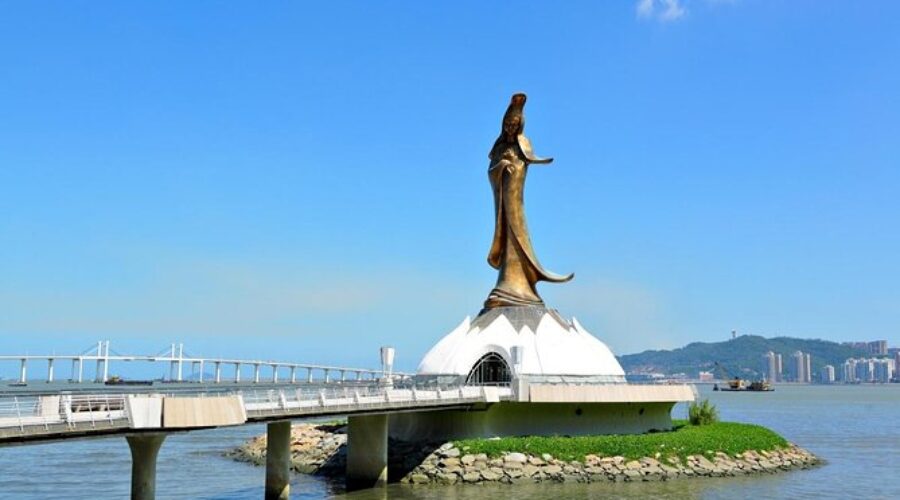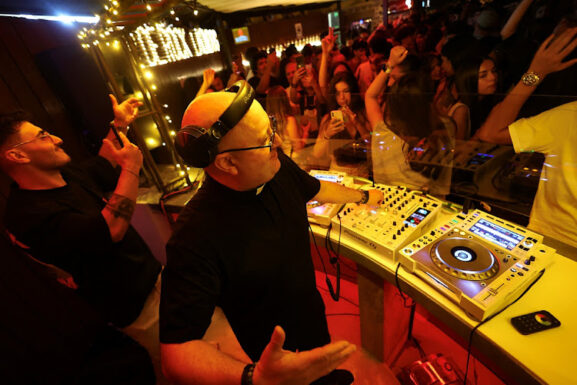Cristina Rocha Leiria, the creator of the Kun Iam statue
Cristina Rocha Leiria has traversed many paths in her life. Growing up in Mozambique, she later studied and worked in Portugal before finding herself in Macau during the city’s transition to Chinese rule. Here, she gained recognition for her design of the Kun Iam statue and the Kun Iam Ecumenical Centre. The genesis of this significant project can be traced back to Ms. Leiria’s youth when, at the age of 17, she found solace and inspiration in a church in Lisbon. Reflecting on her Catholic upbringing, she pondered the accessibility of such spaces to those of differing beliefs or non-believers.
“What a privilege I have as a Catholic to come to a church and feel at home, but someone who is not a Catholic or does not believe in God would not come here so easily as I do. I started thinking that we should have in the world, in big towns, spaces for everybody to find silence and tranquillity.” This contemplation ignited a vision of creating inclusive sanctuaries in bustling urban centres, where all could find serenity amidst the chaos of modern life.
That concept remained in her heart and mind over the years, and it was in the 1990s that it came into fruition following an invitation made by then Governor of Macau Vasco Rocha Vieira, who invited her to design a 20-meter sculpture of Kun Iam, the divinity associated with compassion and mercy adopted by Chinese Buddhism, Confucianism, Taoism, and Chinese folk religion. At the time, Cristina Rocha Leiria suggested building a base for the statue, shaped like a Lotus Flower in concrete, including a Contemplation Room where visitors can rest, listen to music, and read. The cupola is decorated with figures, symbols, and texts related to Lao Tse, Confucius, Mencius, and Buddha, painted on rice paper by the local artists Kwok Woon and Joana Ling, “where people can go and find silence.” As for the location, she proposed three proposals which required placing the statue on a new man-made island, with an Ecumenical Centre and the statue. After consulting with local monks of temples and thoroughly studying the history and culture of Kun Iam and traditional Chinese beliefs, the centre and a 50-ton statue made up of bronze castings were erected and inaugurated on March 21, 1999, located on an artificial island connected to Av. Dr. Sun Yat-sen, NAPE, by a 60-meter long causeway, providing a peaceful space for the public amidst the urban context of a bustling city. The face of the Kun Iam statue was meticulously sculpted, seeking to convey a message of universality and peaceful coexistence. All the elements of this project are based on special energy and Feng Shui principles, Ms. Leiria points out. “The energy of this centre is the energy of a Cathedral,” she stresses. The project quickly earned the support of the United Nations Educational, Scientific, and Cultural Organization (UNESCO) in light of the “integrative and multicultural nature of this initiative.”
Since its inception, Ms. Leiria has been a steadfast steward of the Kun Iam statue, returning to Macau biennially to ensure its preservation amidst the elements.
“I feel much love for this piece of work because it was the broadest project I have been involved in, bringing together architecture, sculpture, decoration, and music (…) “I’m confident that this renovation will be very successful” – Cristina Rocha Leiria
Following a hiatus due to the pandemic, she returned in late 2023 at the invitation of the Cultural Affairs Bureau director, Leong Wai Man, to contribute to the statue’s planned renovation. This endeavour, slated to incorporate representations of Macau’s diverse religious communities, underscores the enduring significance of the Kun Iam monument as a symbol of unity and understanding. As the statue underwent rejuvenation—cleaned, polished, and coated with a protective varnish—local authorities envision an enhanced landmark, drawing visitors from near and far. “I’m confident that this renovation will be very successful,” she said. Ms. Leiria added: “I feel much love for this piece of work because it was the broadest project I have been involved in, bringing together architecture, sculpture, decoration, and music.”
Amidst her many encounters in Macau, one interaction stands out—a chance meeting with two young residents who, upon learning of her role in creating the Kun Iam Statue, expressed profound gratitude, recognizing it as a symbol of their city’s identity. It happened during one of her journeys along the Way of St. James, to Spain’s Santiago de Compostela. She came across two young Macau residents, a man and a woman, who, when she told them that she had worked in Macau and designed the Kun Iam Statue, were astonished. They said: “You know that statue, for us young people, the statue and ecumenical centre are our representation of Macau,” she recalls. “I was so happy for this fortunate encounter.”

